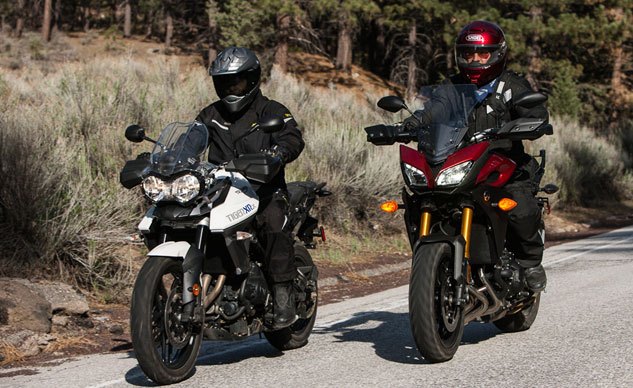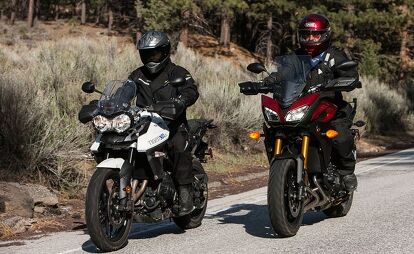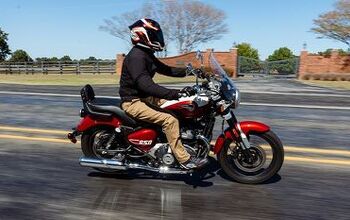Three-Cylinder Sport-Adventure Comparison: Moderation in All Adventurers
2015 Triumph Tiger 800 XRx vs. Yamaha FJ-09
In January, we deduced that the BMW R1200GS Adventure is the best big expensive adventure bike on the market. It seems like only yesterday that we concluded that the new Kawasaki Versys 650 is the best small, (less) expensive one, in our Urbane Adventurers comparison. And just before that, the new-for-2015 Yamaha FJ-09 came out on top of an adventurous pile that included a pair of bigger, more expensive motorcycles. The truth, as they say, is always somewhere in the middle, and if the FJ-09 and its 847cc Triple aren’t right on the epicenter of adventure-bike truth, they’re very close – even if the FJ does roll slightly closer to the streety side of adventuresomeness.
Battle Of The Adventures: BMW Vs. KTM + Video
How convenient, then, that Triumph has just launched its Tiger 800 XRx as a new 2015 model, a bike aimed at the streetier side of life. Triumph’s 800cc Triple-powered adventure bike has been around since its launch in 2011, and it has received a comprehensive overhaul for 2015.
As standard fitment, the XR and XC models receive traction control, ABS and ride-by-wire throttles. XRx and XCx models come fitted with cruise control (the first in its segment) and three riding modes which enable the rider to control throttle response, traction control and switchable ABS. Triumph claim a 17% increase in fuel economy over last year, and we observed a respectable 46 mpg during our flogging. Triumph recently introduced two other Tiger variants, the XCA and XRT, which represent the top of the Tiger 800 line with upgrades aimed at improving rider comfort for longer journeys.
The XCs lean more toward true cross-countryness, with 21-/17-inch wire-spoke wheels and adjustable WP suspenders. The XRs are focused more on street performance, with 19-/17-in. cast wheels, lower seats, and Showa suspension with less travel.
Above the XR, the XRx (the bike we’re testing!) gets many extra features: advanced Riding Modes, selectable throttle maps, cruise control, an advanced trip computer, comfort rider and passenger seats, adjustable windscreen, auto-cancelling turnsignals, centerstand, handguards, and an additional 12-volt power socket. That small x also jacks the price tag $1100 to $12,499. That’s $2,009 more than Yamaha wants for its FJ-09: Is all that stuff worth it?
Our preferred choice for this shootout with the FJ would’ve been the base model XR Tiger, which stickers at $11,399, just $909 more than the FJ. But without one available we had to go with the XRx, giving the Triumph a mighty financial handicap to overcome in our scoring. In true MotoGP analogy, like the time advantage Marc Marquez held over Valentino Rossi at Rio Hondo this year, by the end of shootout the Tiger was doing his best Rossi, looking to pass the FJ. Here’s how our race … er … shootout ended.
And So We Ride
JB says: On the way to meet the other MOrons for a stimulating ride up to Big Bear, California, the Triumph’s comfort seat (adjustable from 31.2 in. to 32.7 in) is highly comforting, as is the ride served up by its Showa suspension. It’s slightly disappointing that the only adjustment is rear preload (easily accomplished via flat-blade screwdriver if you have a firm grip), but we’re also big fans of manufacturers who get the suspension dialled-in at the factory: The XRx provides a perfectly acceptable, just-right freeway ride under my 160 pounds, with excellent ergonomics that let my delicate perineum take full advantage of said comfort seat.
It should be noted that the Tiger’s seat in its low position is a significant 1.4 inches lower than the FJ’s in its low position – an important consideration for short-legged riders. And the seat height comparison is especially noteworthy when one considers the Tiger has almost 2 inches more suspension travel.
The adjustable windshield is really just barely adjustable and a PITA unless you have a 10mm wrench handy, but it’s nice and non-blustery for 5’8” me in its lower position. Handguards are awesome not just on chilly days but for greatly increased peace of mind when heading off pavement: they prevent the bummer that is having to ride back down the rocky mountain road with a busted-off front brake lever, dirt-packed throttle and dislocated pinkie. And then there’s the magic button: electronic Cruise Control. To me, that alone is worth the $1100 premium Triumph gets for the XRx and greatly extends any bike’s range – along with its 5.0-gallon tank and Triumph’s claim of 17%-greater fuel efficiency.
The FJ-09 has most of the important stuff too, including A, Standard and B throttle modes, handguards and a centerstand – but no cruise control, which is a drag since its switchgear and instrumentation look a lot like they came from the big FJR1300, which does have CC. The FJ also doesn’t quite have the level of creature comfort that the Triumph does: Its seat isn’t so plush/supportive, but is adjustable from 33.3 to 33.9 in., and the FJ’s footpegs are more rearward than the Triumph’s. The FJ rotates its rider forward a few degrees into a more aggressive riding position. Still, if you hadn’t just climbed off the Triumph, you’d love the FJ.
Sport Mode
We were highly impressed with the FJ’s sporting chops last time it beat up on the Japanese liter adventurers. Rolling along on its sportbike-issue 17-inch radial tires and Kayaba suspension (5.4 inches/5.1 in. travel F/R), the only thing keeping it from being a “sportbike,” really, is its height: Fast transitions from left to right take a fraction of a second longer.
Other than that, Yamaha’s excellent 106-hp Triple has found a good home in the FJ. In “A” mode (aggressive!), the torquey thing leaps out of the blocks while its flattish handlebar pulls you into a near-supermoto riding position that makes you feel fairly infallible (the FJ, too, comes with handguards). All’s not perfect, though, as the FJ’s throttle, especially in “A” mode, feels twitchy compared to the Tiger’s smoother throttle response. We used Standard mode most of the time because it’s smoother and provides similar engine response, but the Tiger’s EFI/throttle is something for the FJ to aspire to.
The differences between the two Triples are felt in each engine’s willingness to rev. The Tiger’s Triple, with its heavier flywheel, doesn’t feel quite as snappy as the FJ’s on the pavement, but in the dirt the Tiger’s power is more manageable via throttle control where the FJ demands more clutch manipulation to keep things smooth.
We’ve already mentioned the Tiger’s cruise control, but in addition to it, the electronics on the Tiger are far more sophisticated than those on the FJ. For example, the Tiger’s Off-Road mode retains less-aggressive front-wheel ABS while disengaging ABS for the rear wheel, and allows for more rear slippage with the TC. The Tiger’s “Rider” mode allows you to mix and match electronic influences to meet your personal standards – another function lacking on the FJ.
+ Highs
- Sophisticated electronics (cruise control!)
- Comfy seat and ergos
- Better all-rounder
– Sighs
- Toolless windscreen adjustment still requires tools
- Optional hard bags and mounting brackets cost $1k
- Slightly heavier, but still heavier
In the braking department both bikes exhibit perfectly acceptable amounts of braking power and feedback, with the FJ producing slightly more initial bite than the Tiger. Both bikes come standard with ABS. The Triumph’s ABS can be set for “Road,” Off-Road” and “Off,” while the FJ has only “On” and “Off” settings.
The FJ’s fairing/windscreen provides decent protection, and I have no complaints about adverse wind buffeting, but wind noise is abnormally loud for some reason. The Triumph’s protection is more than adequate with no excessive noise or wind buffeting. The Tiger’s windscreen has thumb knobs to adjust its position, but the 10mm acorn nuts inside the screen turn too, requiring a wrench to adjust the screen.
+ Highs
- Almost a sportbike
- Very affordably priced
- If only the FZ-09 had suspension that worked this well
– Sighs
- Not really an off-roader
- No cruise control
- “A” mode remains a little twitchy
At the end of the day, these 800cc Triples really do represent a happy medium. About 100 hp seems like just enough, especially if more power means more weight: 500 pounds is still a lot when the asphalt turns to rocky dirt, but still much easier to pick up than a 570-pound Triumph Explorer or, God forbid, BMW’s 603-lb GSA.
When the numbers were tallied, the ScoreCard reflected how John and I felt about the two bikes. Both of us can justify spending the extra cash on the XRx and that bike won our subjective scoring: 88.3% for the Triumph vs 86.4% for the Yamaha. However, it was the objective scores keeping the FJ in front of Tiger at the end of the race.
Even substituting in the base XR’s lower price didn’t put the Tiger into first place; the on-paper performance advantage of the FJ coupled with its $900 lesser price tag being too much for even the base-model Tiger to overcome. You’d then have to factor in the lesser electronics package of the base model XR, meaning its scores in that category would also be lower.
In that light, we’re forced to give the win to the Yamaha FJ. So, no fairytale ending to this shootout for the Triumph. In more of a professional boxing type of split-decision – one in which we may not agree with the outcome, but we’re stuck with anyway – the Yamaha FJ-09 just simply cannot be overcome this time around.
| Three-Cylinder Sport-Adventure Comparison Scorecard | ||
|---|---|---|
| Category | Triumph Tiger 800 XRx | Yamaha FJ-09 |
| Price | 83.9% | 100% |
| Weight | 95.0% | 100% |
| lb/hp | 79.0% | 100% |
| lb/lb-ft | 85.9% | 100% |
| Engine | 91.3% | 92.5% |
| Transmission/Clutch | 88.8% | 85.0% |
| Handling | 82.5% | 82.5% |
| Brakes | 83.8% | 90.0% |
| Suspension | 86.3% | 87.5% |
| Technologies | 96.3% | 82.5% |
| Instruments | 83.8% | 86.3% |
| Ergonomics/Comfort | 90.0% | 81.3% |
| Quality, Fit & Finish | 90.0% | 82.5% |
| Cool Factor | 87.5% | 87.5% |
| Grin Factor | 87.5% | 86.3% |
| Overall Score | 88.0% | 89.1% |
| Three-Cylinder Sport-Adventure Comparison Specs | ||
|---|---|---|
| Triumph Tiger 800 XRx | Yamaha FJ-09 | |
| MSRP | $12,499.00 | $10,490 |
| Engine Type | 800cc liquid-cooled inline Triple | 847c liquid-cooled Inline Three-cylinder |
| Bore and Stroke | 74.05 x 61.94mm | 83.0 x 60.0mm |
| Fuel System | multipoint sequential EFI; ride-by-wire | EFI; ride-by-wire |
| Ignition | Computer-controlled digital transistorized with electronic advance | Electronic |
| Compression Ratio | 12.0:1 | 11.5:1 |
| Valve Train | DOHC; 4 valves per cylinder | DOHC; 4 valves per cylinder |
| Emissions | EPA, CARB compliant | EPA, CARB-compliant |
| Horsepower | 87.0 @ 9100 rpm | 104.1 @ 9900 rpm |
| Torque | 54.1 @ 7700 | 59.8 @ 8300 rpm |
| lb/hp | 5.70 | 4.50 |
| lb/torque | 9.20 | 7.90 |
| Transmission | 6-speed; multi-plate wet clutch | 6-speed, multi-plate wet clutch |
| Final Drive | Chain | Chain |
| Front Suspension | 43mm Showa fork; 7.09 in. travel | 41mm fork; adjustable preload and rebound damping; 5.4-in travel |
| Rear Suspension | Showa single shock; hydraulic spring preload adjustment; 6.7 in. travel | Single shock; adjustable preload and rebound damping; 5.1 in. travel |
| Front Brake | Dual 308mm disc; 2-piston Nissin calipers, switchable ABS | Dual 298mm discs; 4-piston calipers, ABS |
| Rear Brake | 255mm disc; single-piston Nissin caliper, switchable ABS | 245mm disc; single-piston caliper, ABS |
| Front Tire | 100/90-19 | 120/70ZR-17 |
| Rear Tire | 150/70R-17 | 180/50ZR-17 |
| Rake/Trail | 23.9° / 3.64 in. | 24 deg. / 3.9 in. |
| Wheelbase | 60.23 in. | 56.7 in. |
| Seat Height | 31.9/32.7 in. (31.1/31.9 low seat option) | 33.3/33.9 in. |
| Curb Weight | 497 lb. | 472 lb. |
| Fuel Capacity | 5.0 gal. | 4.8 gal. |
| Tested Fuel Economy | 46 mpg | 43 mpg |
| Available Colors | Blue, Black, White | Red, Matte Gray |
| Warranty | Two year, unlimited-mileage | One year limited warranty |
More by John Burns












































































































Comments
Join the conversation
Having just test rode the Fj I came away impressed, then I rode a Tiger XCX, it just fit me, felt better, throttle was much better so if I was in the market to replace he Uly I would pony up the extra cash and go with the Triumph. Now if they only had the bottom end of my Buell…...
Love the Tiger but the testers should never have gone off-road on the FJ. It's not a Adventure bike, never advertised as one...